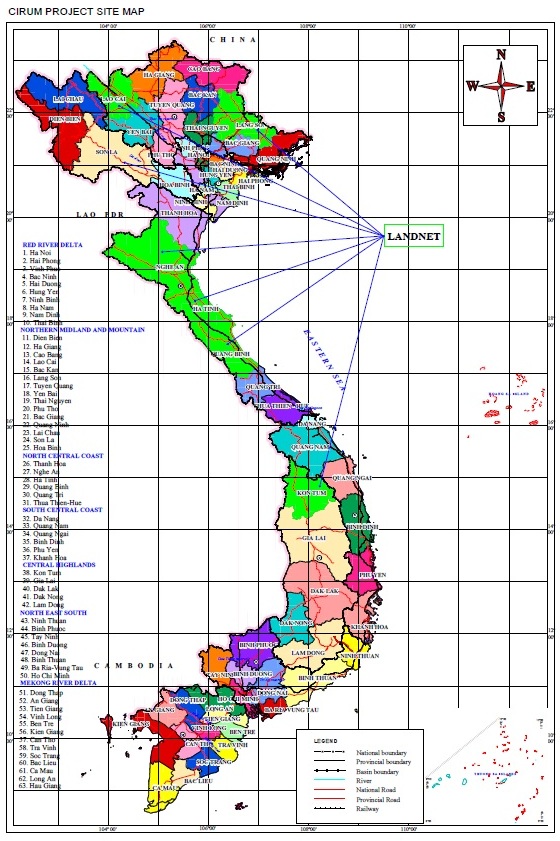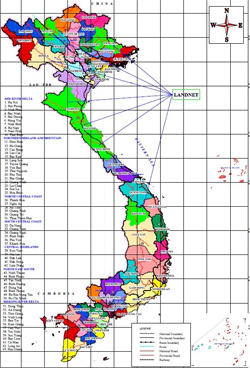Project sites of LandNet
Until 2018, LandNet has project sites in 7 provinces, including Lao Cai, Son La, Lang Son, Nghe An, Ha Tinh, Quang Binh and Kon Tum. Currently LandNet had 146 active members, of whom 32 are women. Most of LandNet members belong to ethnic minority groups: Thai, H’Mong, Nung, Tay, Dao, Ma Lien, Ro Ngao, Ja Rai and Kinh. All of the members participate in LandNet activties willingly, in the hope of self-improving and sharing experiences on effective forest land use and management with each other.
Evidence models in relation to forest land management
Since establishment in 2013, in collaboration with LandNet Secretariate, local authorities, experts, organizations of LISO (CIRUM/CODE/SPERI) and other organizations, LandNet has organized and implemented programs/activities in action research and developing forest land protection and management models, in both household and community levels. The results of these activties are evidences to be used for sharing among LandNet members, in particcular for lobby/advocacy, e.g., to contribute to the Forestry Law Revision 2004 in the coming years.
Details on evidence models in all project sites are as follows.
 LandNet Project Sites Map
LandNet Project Sites Map
Household level:
1. Sustainable forest land protection, development and management model implemented by Ms. Vi Thị Hòa and Mr. Ha Van Chau in Khe Vap Village, Bac Lang Commune, Dinh Lap District, Lang Son Province.
2. Agroforestry farming model by Mr. Tran Trong Binh in Son Kim 1 Commune, Huong Son District, Ha Tinh Province.
3. Natural Forest protection, development and management model by the household of Ms. Tran Thi Dao and Mr.Tran Ngoc Lam in Son Kim 1 Commune, Huong Son District, Ha Tinh Province.
4. Local forestry nursery model by Mr. Nguyen Tien Ho in Khe 5 Village, Son Kim 1 Comune, Huong Son District, Ha Tinh Province.
5. Forest enrichment and recovery by local forestry plants model by the family of Ms. Le Thi Nguyet and Mr. Huu Van Nhang in Ho Muoi Village, Minh Son Commune, Huu Lung District, Lang Son Province.
Community level:
1. Community based forest management done by H’mong communities in Lung Sui Commune, Si Ma Cai District, Lao Cai Province;
2. Community based forest management done by H'Mong & Nung comunities in Sin Cheng Commune, Si Ma Cai District, Lao Cai Province;
3. Community based forest management done by H’mông communities in Cao Sơn Commune, Mường Khương District, Lào Cai Province;
4. Community based forest management done by Dzao communities in Den Sang Commune, Bat Xat District, Lao Cai Province;
5. Community based forest management done by H’mong villagers in On Oc Village, Muong Lum Commune, Yen Chau District, Son La Province;
6. Community forest management done by Nung villagers in Ho Muoi Village, Minh Son Commune, Huu Lung District, Lang Son Province;
7. Community based forest management done by Thai villagers in Hanh Dich Commune, Que Phong District, Nghe An Province;
8. Community based forest management done by Thai communities in Dong Van Commune, Que Phong District, Nghe An Province;
9. Forest management done by villagers in Khe 5 Village, Son Kim Commune, Huong Son District, Ha Tinh Province;
10. Customary law based community forest management implemented by local villagers in Uyen Phong Village, Chau Hoa Commune, Tuyen Hoa District, Quang Binh Province;
11. Community based Forest management model implememted by local villagers in Cao Quang Commune, Tuyen Hoa District, Quang Binh Province;
12. Customary law based Community forest management implemented by Ro Ngao people in Ho Moong Commune, Sa Thay District, Kon Tum Province.
13. Customary law based Community forest management implemented by Xe Dang people in Tu Mo Rong Commune, Tu Mo Rong District, Kon Tum Province























